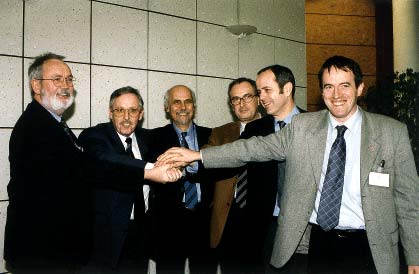Introduction
The signing of the Memorandum of Understanding of the Partnership for Structural Biology stands out among the many significant events of 2002 in terms of its potential impact on the ESRF and on its neighbouring institutes. After almost two years of discussion and preparation the MoU was signed on 15 November by the Directors (or their representatives) of the European Molecular Biology Laboratory (EMBL), the ESRF, the Institut de Biologie Structurale (IBS), and the Institut Laue-Langevin (ILL). The opening ceremony was attended by a number of local and national dignitaries including Prof B. Bigot, Directeur du Cabinet de la Ministre déléguée à la Recherche et aux Nouvelles Technologies. The four partner institutes will now work to combine their expertise in state-of-the-art molecular biology to tackle crucial problems in research related to issues of human health.
 |
|
PSB opening ceremony. |
The ESRF's contribution to the partnership involves three components. First, our scientists will take a substantial part in the execution of the ambitious joint scientific programme. The ESRF will make a major financial commitment to the laboratory/office building, to be situated between the EMBL building and the ESRF's Experimental Hall. The third, and most striking of the ESRF's contribution is the new ID23 beamline complex. Two new highly-automated beamlines for high-throughput macromolecular structure determination are under construction; the first station will be commissioned towards the end of 2003, with the second following about one year later. The ID23 beamline represents a major increase of our capacity in this critical area of research and will allow a series of specific PSB investigations to supplement our current user, in-house and industrial research programmes. We look forward to a continued expansion of the PSB's activities, as our site becomes an internationally leading centre for structural and functional biology.
 |
|
Inauguration of FaME38. |
We also made progress on other important research collaborations. The Facility for Materials Engineering (FaME 38) was inaugurated on 26 November 2002. This joint ILL-ESRF initiative, involving a number of U.K. universities, has the objective of providing scientific and technical support for engineering and materials science investigations at our complementary facilities. Another important milestone was the signature of the EIROforum charter, uniting the seven major European intergovernmental research organisations (CERN, EFDA-JET, EMBL, ESA, ESO, ESRF, ILL) in a number of joint actions to promote European science. This event took place at the launch of the EC's 6th Framework Programme in Brussels on 11-13 November 2002; the ESRF presence was marked by an impressive stand presenting the full range of our activities.
 |
|
Signature of the EIROforum charter. |
Closing this "international" chapter, we would like to note that an extension of the agreement between the ESRF and the Czech Republic was signed on 20 September 2002 during a visit by Professor Jungwirth, representing the Institute of Physics of the Czech Academy of Sciences. Furthermore, the Austrian Academy of Science became a new associate of the ESRF and the Portuguese government renewed its agreement with the ESRF, both from January 2003. These agreements testify to the scientific success and attractiveness of the ESRF, as do the 750 refereed publications produced during 2002, describing research carried out at the ESRF.
In 2002, over 5300 hours of X-ray beam were delivered to the beamlines with an availability of 98% if we disregard the 1% necessarily used for refills. The mean time between failures reached a record 57.8 hours this statistic is especially meaningful, as the most sensitive experiments on the beamlines often require long periods of stable uninterrupted beam. The programme of Machine upgrades to improve performance and reliability is mirrored by a continuous refurbishment and renewal programme on the beamlines. Of particular importance is the refinement of beamline optics. The Optics Group has been responsible for many advances in focusing techniques, notably the supermirror Kirkpatrick-Baez system that can now provide a focal spot of less than 100 by 100 nanometres at an X-ray energy of 20 keV. These devices will have many applications on a large number of beamlines.
Other noteworthy changes during the last year include the creation of the Industrial and Commercial Unit, to further focus our commercial activities, and the Communication Unit, to strengthen our communication interactions, both internal and external. The new ESRF web site, born of a strong multi-divisional collaboration, came on-line towards the end of 2002 and will allow improved presentation of the ESRF and its activities towards the scientific community and the wider public.
In this short introduction it is not possible to mention all of the events and developments that took place during the last year. So let us end by thanking all of those who contributed to the ESRF's scientific success - staff, users, scientific collaborators, and delegations. In the following pages you will find a comprehensive summary of the Scientific Highlights of the year 2002 which should provide a "flavour" of the remarkably diverse range of scientific phenomena investigated at the ESRF.
W.G. Stirling, P. Elleaume, H. Krech, F. Sette
(January 2003)



